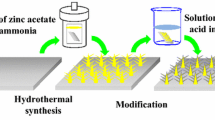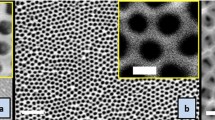Abstract
A superhydrophobic surface with a water contact angle of 166.0° and a tilting angle of 1.5° was fabricated on an aluminum substrate by electrochemical machining using neutral NaNO3 electrolytes, followed by fluorination. The fabrication process is based on the fact that the grain boundaries and dislocations on aluminum are anodic dissolved before the grain itself by an applied electric field. Using scanning electron microscopy to analyze surface morphology, micrometer scale caves, and protrusions were found on the surface, with numerous nanometer mastoids contained in the protrusions. These binary micro-nano rough structures, which are similar to the micro-structures of a lotus leaf surface, play an important role in achieving superhydrophobicity. The effects of processing time, processing current, and electrolyte concentration on superhydrophobicity were also examined. The results show that electrochemical machining does not require rigid processing parameters, uses a simple device, and is highly efficient and environmental friendly. The optimum processing conditions are a processing time of 60 min, a processing current of 250 mA, and an electrolyte of 0.15 mol/L.






Similar content being viewed by others
References
Barthlott W, Neinhuis C (1997) Planta 202:1
Gao XF, Jiang L (2004) Nature 432:36
Wang H, Tang LM, Wu XM, Dai WT, Qiu YP (2007) Appl Surf Sci 253:8818
Wagner T, Neinhuis C, Barthlott W (1996) Acta Zool 77:213
Furstner R, Barthlott W, Neinhuis C, Walzel P (2005) Langmuir 21:956
Lee HJ (2009) J Mater Sci 44:4645. doi:https://doi.org/10.1007/s10853-009-3711-5
Hayn RA, Owens JR, Boyer SA (2011) J Mater Sci 46:2503. doi:https://doi.org/10.1007/s10853-010-5100-5
Mchale G, Shirtcliffe NJ, Evans CR, Newton MI (2009) Appl Phys Lett 94:064104
Watanabe K, Yanuar, Udagawa H (1999) J Fluid Mech 381:225
Shi F, Niu J, Liu JL, Liu F, Wang ZQ, Feng XQ, Zhang X (2007) Adv Mater 19:2257
Liu T, Yin YS, Chen SG, Chang XT, Cheng S (2007) Electrochim Acta 52:3709
Yin YS, Liu T, Chen SG, Liu T, Cheng S (2008) Appl Surf Sci 255:2978
Kulinich SA, Farzaneh M (2009) Appl Surf Sci 255:8153
Yin L, Xia Q, Xue J, Yang SQ, Wang QJ, Chen QM (2010) Appl Surf Sci 256:6764
Cao LL, Jones AK, Sikka VK, Wu JZ, Gao D (2009) Langmuir 25:12444
Tourkine P, Merrer ML, Quere D (2009) Langmuir 25:7214
Suzuki S, Nakajima A, Yoshida N, Sakai M, Hashimoto A, Kameshima Y, Okada Y (2007) Chem Phys Lett 445:37
Wang H, Tang LM, Wu XM, Dai WT, Qiu YP (2007) Appl Surf Sci 253:8818
Ohkubo YJ, Tsuji I, Onishi S (2010) J Mater Sci 45:4963. doi:https://doi.org/10.1007/s10853-010-4362-2
Shirtcliffe NJ, Mchale G, Newton MI, Chabrol G, Perry DC (2004) Adv Mater 16:1929
Qian BT, Shen ZQ (2005) Langmuir 21:9007
Larmour IA, Bell SEJ, Saunders GC (2007) Angew Chem 119:1740
Thieme M, Frenzel R, Schmidt S, Simon F, Hennig A, Worch H, Lunkwitz K, Scharnweber D (2001) Adv Eng Mater 3:691
Wenzel RN (1936) Ind Eng Chem 28:988
Cassie ABD, Baxter S (1996) Trans Faraday Soc 40:546
Henderson B (1972) Defects in crystalline solids. Edward Arnold Ltd, London
Hull D, Bacon DJ (2001) Introduction to dislocations. Butterworth-Heinemann, Oxford
Feng L, Li SH, Li YS, Li HJ, Zhang LJ, Zhai J, Song YL, Liu BQ, Jiang L, Zhu DB (2002) Adv Mater 14:1857
Acknowledgement
The authors thank for the financial support from the National Science Foundation of China (No. 90923022).
Author information
Authors and Affiliations
Corresponding author
Rights and permissions
About this article
Cite this article
Xu, W., Song, J., Sun, J. et al. Fabrication of superhydrophobic surfaces on aluminum substrates using NaNO3 electrolytes. J Mater Sci 46, 5925–5930 (2011). https://doi.org/10.1007/s10853-011-5546-0
Received:
Accepted:
Published:
Issue Date:
DOI: https://doi.org/10.1007/s10853-011-5546-0




